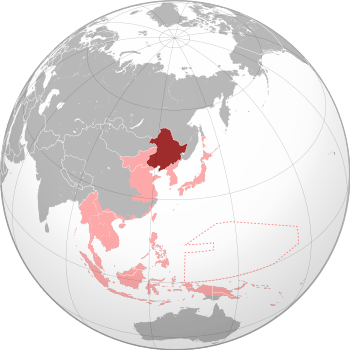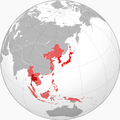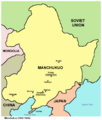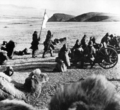Manchukuo facts for kids
Quick facts for kids
State of Manchuria (Manchukuo) (1932–1934)
滿洲國 Empire of (Great) Manchuria (1934–1945) (大)滿洲帝國 |
|||||||||
|---|---|---|---|---|---|---|---|---|---|
| 1932–1945 | |||||||||
|
Motto: "Five Races Under One Union"
|
|||||||||
|
Anthem: National Anthem of Manchukuo
|
|||||||||

Manchukuo (dark red) within the Empire of Japan (light red) at its furthest extent
|
|||||||||
| Status | Client state/Puppet state of the Empire of Japan | ||||||||
| Capital | Hsinking (Changchun) (until 9 August 1945) Tonghua (from 9 August 1945) |
||||||||
| Common languages | Japanese Manchu Mandarin Mongolian |
||||||||
| Religion | State Shinto | ||||||||
| Government | One-party constitutional monarchy under an authoritarian-personalist dictatorship | ||||||||
| Chief Executive | |||||||||
|
• 1932–1934
|
Aisin-Gioro Puyi | ||||||||
| Emperor | |||||||||
|
• 1934–1945
|
Aisin-Gioro Puyi | ||||||||
| Prime Minister | |||||||||
|
• 1932–1935
|
Zheng Xiaoxu | ||||||||
|
• 1935–1945
|
Zhang Jinghui | ||||||||
| Legislature | Legislative Council | ||||||||
| Historical era | Interbellum · World War II | ||||||||
|
• Proclaimed
|
18 February 1932 | ||||||||
| 15 August 1945 | |||||||||
| Area | |||||||||
| 1940 est. | 1,192,081 km2 (460,265 sq mi) | ||||||||
| Population | |||||||||
|
• 1940 est.
|
35,000,000 | ||||||||
| Currency | Manchukuo yuan | ||||||||
|
|||||||||
Manchukuo was a puppet state of the Empire of Japan in China and Inner Mongolia from 1932 until 1945. It was first a republic, but in 1934 it became a constitutional monarchy. It had little international recognition and was under the Unofficial control of Japan.
The place, called Manchuria, was the place of the Manchus, including the kings of the Qing dynasty. In 1931, Japan occupied Manchuria after the Mukden Incident. A pro-Japanese government was created one year later with Puyi, the last Qing emperor, as the nominal regent and later emperor. Manchukuo's government was removed in 1945 at the end of World War II. The Soviet Union invaded in August 1945, and formally transferred the territory to Chinese administration in the following year. Although the territories came under the jurisdiction of the Nationalist government, the brief Soviet occupation helped make the region into a base for the Chinese Communist troops led by Mao Zedong. The People's Liberation Army got Japanese equipment and a strategic advantage against the National Revolutionary Army led by Chiang Kai-shek.
Manchus formed a minority in Manchukuo, whose largest ethnic group were Han Chinese. The population of Koreans increased during the Manchukuo period, and there were also Japanese, Mongols, White Army Russians and other minorities. The southern part of the Liaodong Peninsula was ruled by Japan as the Kwantung Leased Territory.
Images for kids
-
Members of the Greater East Asia Co-Prosperity Sphere; territory controlled at maximum height. Japan and its allies in dark red; occupied territories/client states in lighter red. Korea and Taiwan were at that time considered integral parts of Japan and governed directly by the Japanese government, unlike client states such as Manchukuo that functioned under puppet governments.
-
Puyi as Emperor Kangde of Manchukuo
See also
 In Spanish: Manchukuo para niños
In Spanish: Manchukuo para niños
















